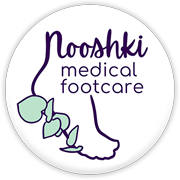
A corn or callus is considered a soft tissue pathology. They are caused by pressure/stress exerted on the tissues of the foot. As we age, our foot becomes drier and less elastic from decreased sweat glands, which increases chance of acquiring corns or calluses.
A callus is a thickened layer of tissue over an area that is subject to excessive pressure and shearing. Calluses are often white, yellow or brown as they lose elasticity. If left untreated, they can develop fissures (splits in the skin) that can become open and infected. This is especially dangerous for clients that are diabetic and/or have neuropathy.
Hard corns, medically referred to as heloma durum, are the most common types of corns. They are caused by excessive pressure over a joint or deformity, usually due to poorly fitting footwear. It is important to treat corns as they can lead to complications, especially in clients who are living with diabetes or connective tissue disorders.
Preventing the recurrence of calluses and hard corns:
- Wash your feet on a daily basis.
- Soak daily for no more than 5 minutes.
- Completely dry each foot, especially between the toes.
- Wear properly fitting shoes and socks.
- Wear padding and/or orthotics as recommendation to offload areas of pressure.
A soft corn, medically called a helomamolle, forms where there is bone on bone contact between toes, where it is constantly moist due to lack of evaporation. The surrounding tissue is macerated (like pruned skin) in appearance. This most commonly occurs between 4th and 5th digit of the foot.
Preventing soft corns:
- Use mild cleanser and astringents to reduce maceration.
- Ensure area between toes is completely dry.
- Use toe separators to reduce skin on skin contact between toes.
- Wear shoes with a wide toe box that does not squeeze toes together.
How we treat corns and calluses:
- Nooshki Footcare Nurse visits your home.
- Our nurse will gently reduce the thick layer of skin of the corn. This does not hurt, as it is only dead skin that is being removed.
- The area is then filed down so that the surface is smooth.
- We use a urea based cream application to prevent a hard corn from re-forming.
- For a soft corn, a toe separator or padding should be used to allow the area to dry. No lotions will be used between the toes.
- Complete foot and nail care to rest of your toes and lower limbs.
- We provide health teaching and tips about protecting the feet, and specifically the fresh corn/callous area with appropriate padding and proper fitting shoes.
- All teaching info and instructions discussed as well as more relevant care tips will be provided in a handout form for clients to easily reference.


